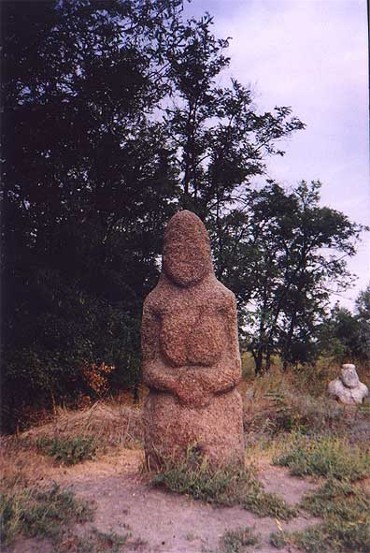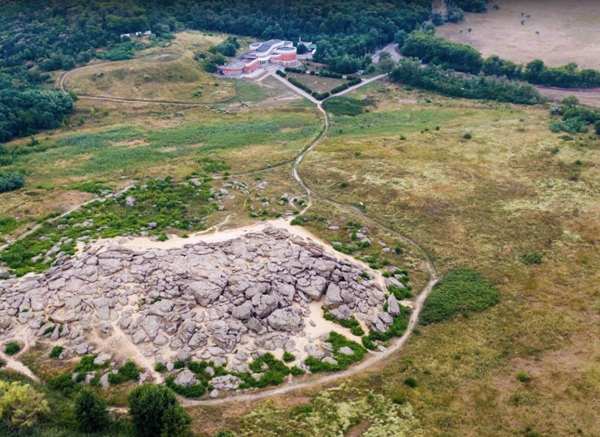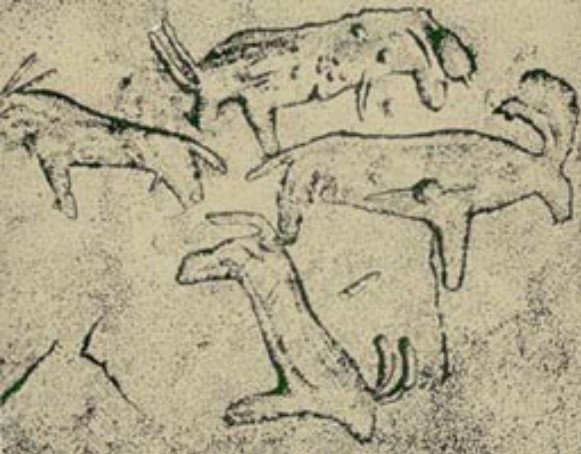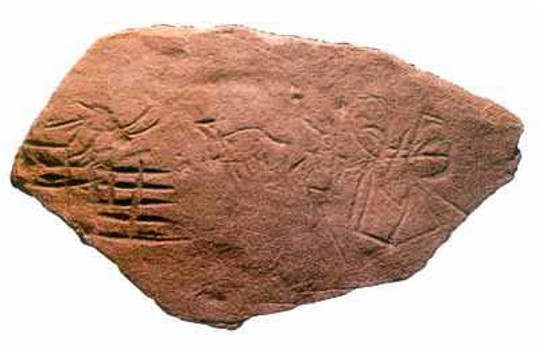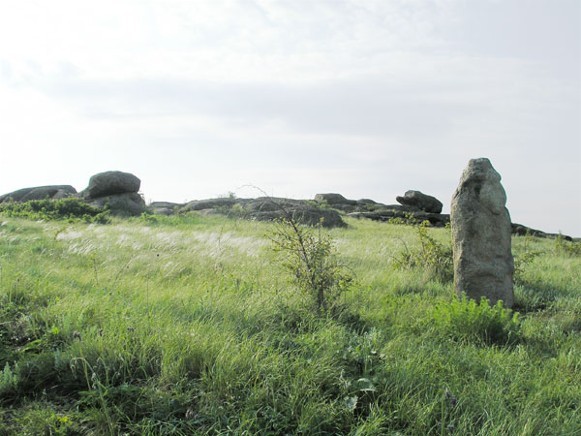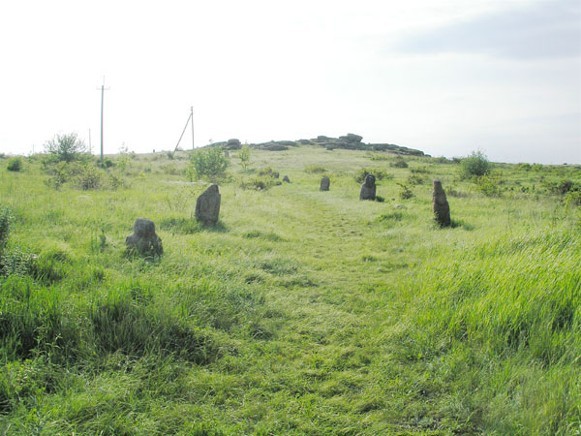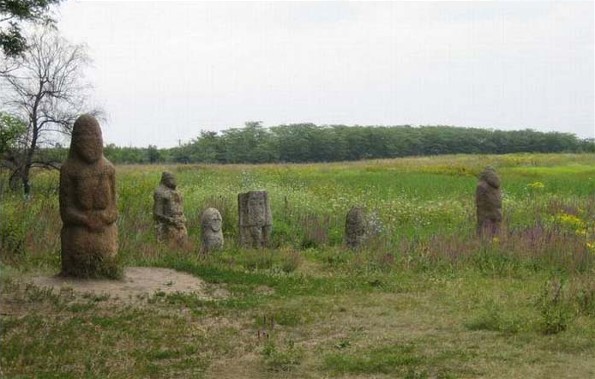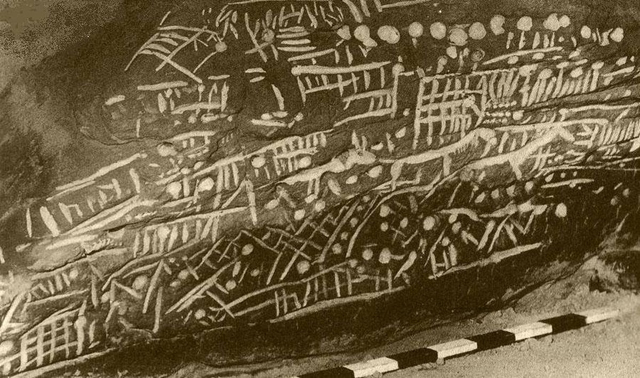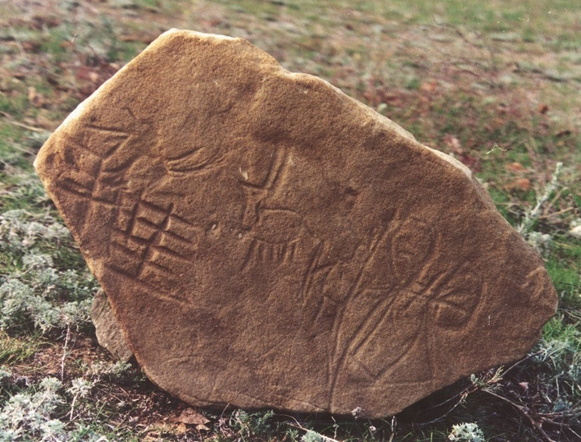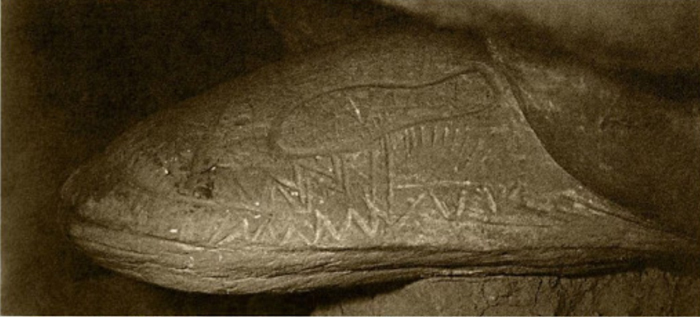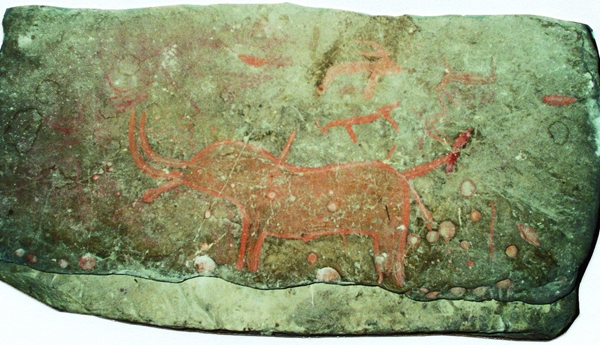Kamiana Mohyla
Kamiana Mohyla [Кам’яна Могила], sometimes spelled Kamyana Mohyla. A knoll of sandstone deposits from the Miocene epoch resembling a large kurhan, situated on the right bank of the Molochna River near Terpinnia, Melitopol raion, Zaporizhia oblast. It’s height reaches up to 18 m; the hill is approximately 165 m long and 90 m wide and covers an approximate area of 3 ha. A unique geological formation, Kamiana Mohyla is considered by the majority of archeologists to be a natural monument; however, some geologists question the possibility of its natural formation, and claim that it must be considered, at least partially, as a man-made construction. It is composed of over 3,000 large fairly loosely assembled sandstone slabs. Underneath and in-between these slabs 68 caves, grottos, and other locations have been discovered to date containing ancient petroglyphs of wild bulls, wolves, horses, and other animals, human beings, and geometric patterns dating back to the Upper Paleolithic Period, the Mesolithic Period, the Neolithic Period, the Eneolithic Period, and the Bronze Age, when Kamiana Mohyla was a site of religious worship. Some petroglyphs created by the Scythians and Sarmatians have also been discovered. The most recent petroglyphs date back to the princely era of Kyivan Rus’ and include Christian symbols.
Known in Turkic as ‘YuYun-Tashch’ (meaning, roughly, a mound of gathered stones), Kamiana Mohyla was first mentioned in 1739 in autobiographical writings by German physician and botanist Johann Jakob Lerche. Later it was described in more detail in an article by Peter Köppen in 1837. The first caves at the site were discovered by Nikolai Veselovsky in 1890. But a serious investigation of Kamiana Mohyla began only in 1936–8 during archeological excavations organized by the Institute of Archeology of the Academy of Sciences of the Ukrainian SSR and led by Otto Bader and Valentyn Danylenko. At that time, one of the best known caves in this complex, the so-called ‘Grotto of the Bull,’ was excavated and studied. Danylenko continued his explorations of Kamiana Mohyla in 1947. Between 1951 and 1957 several excavations were led by Mykhailo Rudynsky whose major monograph on Kamiana Mohyla was published in 1961. In the 1960s the site was studied by Vladyslav Hladylin and Borys Mykhailov, while in the 1970s excavations were conducted by Danylenko (who discovered, among others, the ‘Cave of the Sorcerer’ with some of the oldest petroglyphs on the site) and Mykhailov. Later Mykhailov was the primary investigator of Kamiana Mohyla and the organizer of extensive excavations of the site between 1983 and 2006. During these years he discovered numerous new caves and grottos and published a comprehensive study of Kamiana Mohyla’s petroglyphs in 2005.
The problem of the exact dating of the petroglyphs at Kamiana Mohyla is quite difficult to resolve. Some archeologists estimate that the oldest petroglyphs date back to 22nd millennium BC; others see them as considerably less ancient. Some archeologists believe that the oldest petroglyphs were created during the Upper Paleolithic Period; the most remarkable of them are found in the ‘Cave of the Sorcerer,’ the ‘Cave of the Bison,’ and the ‘Cave of the Mysteries.’ The subject matter of these petroglyphs corresponds quite closely to the subject matter of the Paleolithic cave art found in Western Europe. Petroglyphs dating back to the Mesolithic Period are found mainly in the ‘Cave of the Goat’ and the ‘Cave of the Bison’; some of the carved and painted compositions in the latter cave are interpreted as the earliest representations of mythological stories found in Ukraine. The most numerous of artworks at Kamiana Mohyla date back to the Neolithic Period and, even more so, to the Eneolithic Period. They include petroglyphs in the ‘Grotto of the Bull,’ the ‘Cave of the Fish,’ the ‘Grotto of the Dragon,’ and other caves, as well as sculptures in the ‘Cave of Artemis,’ the ‘Grotto no. 55,’ and others. A separate category of images dating, most likely from the Bronze Age or Iron Age, are representations of horses that reflect the process of the domestication of the horse in the Eurasian steppe. Petroglyphs from various time periods include very numerous pictographic symbols that represent some of the oldest examples of proto-writing found on the territory of Ukraine. Some later petroglyphs at Kamiana Mohyla date back to the Scythian and, more numerously, Sarmatian times and even to the medieval Kyivan Rus’ epoch of the 10th century AD.
No evidence of settled occupation was found at Kamiana Mohyla itself. Apparently, the site was used exclusively as a place of worship. However, over a dozen campsites and settlements dating back from the Paleolithic Period to the Eneolithic Period and even the Bronze Age and Iron Age were discovered and excavated in the close vicinity of Kamiana Mohyla. Almost certainly, these settled communities were closely tied to the site of Kamiana Mohyla and its religious purpose.
Kamiana Mohyla was designated as an archeological preserve in 1954. In 1986, on the initiative of Borys Mykhailov, a museum dedicated to Kamiana Mohyla was established in the vicinity of the site. In 2008 the Kamiana Mohyla Historical and Archeological Reserve was granted the national preserve status.
BIBLIOGRAPHY
Rudnyts'kyi, Mykhailo. Kam’iana Mohyla (Kyiv 1961)
Pieshanov, V. Kam’iana Mohyla (Dnipropetrovsk 1967)
Mykhailov, Borys. Kam’iana Mohyla/Stone Tomb/Kamienna Mogiła (Dnipropetrovsk 1976)
Danylenko, V. Kam’iana Mohyla (Kyiv 1986)
Mykhailov, Borys. Kam’iana Mohyla – svitova pam’iatka starodavnioï kul'tury v Ukraïni: fotoal'bom (Kyiv 2003)
Mykhailov, Borys. Petrohlify Kam’ianoï Mohyly: Semantyka, khronolohiia, interpretatsiia (Kyiv 2005)
The official site of the Kamiana Mohyla National Historical and Archeological Reserve: http://www.stonegrave.org/
Marko Robert Stech
[This article was updated in 2022.]
